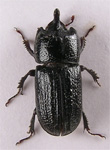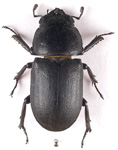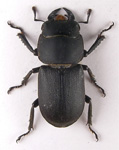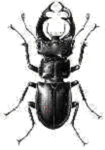Adult lucanids burrow into wood to lay eggs, all species are polyphagous (generally angiosperms) and larvae are long lived e.g. more than three years in Lucanus. All are common where found across England and Wales becoming rarer northwards although Sinodendron can be elusive. They are best searched for at night when large numbers may be found, during the day Dorcus may be found under logs or in bark crevices, Sinodendron flies in hot sun or may be found crawling on trunks. Although Dorcus and Sinodendron occur throughout the year, warm sunny days and humid evenings are the best time to find them.
10-75mm. Mandibles well developed and visible, in male, Lucanus enlarged and used for competing with other males, female mandibles normal. Antennae genticulate and asymetrically clubbed, the segments forming this are thick and not close fitting (cf Scarabaeidae, Geotrupidae). Tarsi 5 segmented, claws robust and with a well developed bisetose empodium between , this is absent or very small in other Scarabaeoidea families. 5 visible sternites.
Identification is straightforward, Jessop, Britton and Joy all deal with the group as do many colour guides. There are several fairly recent accounts of Lucanus ¹ distribution but Colin Pratt's extensive review ² is a must for anybody interested in the species.
¹ Clarke, J.T., 1966. The distribution of Lucanus cervus (L.) in Britain. Ent.Mon.Mag.. 102:199-204
Hall, D.G. 1970. Lucanus cervus (L.) in Britain. Ent.Mon.Mag. 105:183-184.
² Pratt, C.R. 2003. A modern review of the history of the Stag beetle, Lucanus cervus (L.) in Great Britain. Booth museum of Natural history, Brighton. (CDROM).

Sinodendron
cylindricum

Sinodendron
cylindricum

Dorcus parallelipipedus F

Dorcus parallelipipedus M

Lucanus cervus